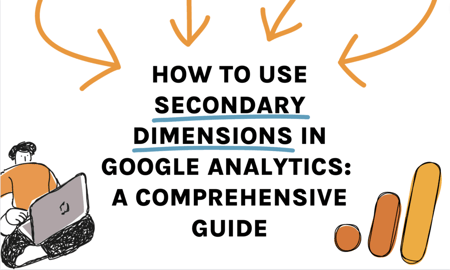Enhance Your Data Analysis Using Secondary Measurements
In the realm of information evaluation, key metrics typically offer a fundamental understanding of performance or trends. Nonetheless, truth depth of understandings hinges on the combination of secondary dimensions. These added layers of data offer a nuanced view that can unwind intricacies and nuances not noticeable in the beginning look. The capacity to divide information via different lenses opens doors to a world of possibilities that can change exactly how organizations act and interpret upon their information. The strategic use of second dimensions elevates evaluation beyond the surface area degree, guaranteeing a wealth of untapped possible waiting to be uncovered.
Comprehending Second Dimensions
Second dimensions in information evaluation describe extra attributes or metrics that supply much deeper understandings when integrated with primary data dimensions, enhancing the general understanding of the dataset. These additional dimensions supply an even more extensive view of the data, allowing experts to discover covert patterns, partnerships, and patterns that might not be noticeable when just taking into consideration key dimensions.
By integrating second dimensions right into data evaluation, experts can get an extra nuanced understanding of the aspects affecting the main metrics. As an example, in marketing analysis, main measurements can include fundamental consumer demographics like age and gender, while second dimensions might incorporate variables such as acquiring habits, preferences, or geographic place. By integrating these additional and key measurements, experts can develop a lot more comprehensive client profiles, making it possible for even more targeted and efficient marketing strategies.
Moreover, secondary dimensions can help in determining correlations between various variables, causing even more precise predictive modeling and decision-making. They allow experts to discover information from numerous point of views, enriching the insights drawn from the dataset and eventually improving the quality of analysis and strategic referrals.
Advantages of Second Dimensions
When taking into consideration data analysis, integrating secondary measurements supplies a plethora of benefits that substantially improve the deepness and breadth of insights obtained from primary information dimensions. By adding secondary dimensions such as time, place, or demographic information to the evaluation, scientists can gain a much more extensive understanding of the primary data points.
Furthermore, secondary measurements can also help in segmenting data, enabling an extra detailed evaluation of certain parts within the primary data. This segmentation can lead to even more targeted strategies and actions based on the distinct attributes of each sector. In addition, secondary measurements can aid in verifying searchings for from main information dimensions, providing an extra reputable and durable basis for decision-making.
Fundamentally, the advantages of integrating additional measurements into data evaluation are important, supplying richer insights and allowing more informed decision-making processes.
Carrying Out Additional Measurements Properly
Reliable application of additional measurements in data evaluation requires a calculated approach that makes the most of the energy of extra contextual info. When including secondary measurements, it is important to straighten them with the primary measurements to gain much deeper insights right into the data. Start by clearly defining the objectives of the evaluation to figure out which secondary dimensions will give one of the most relevant context. It is vital to select secondary dimensions that enhance the key information without creating noise or confusion in the evaluation.
In addition, consider the scalability of the additional dimensions throughout different datasets or evaluations. By executing additional measurements efficiently, experts can enhance the deepness and accuracy of their information evaluation, leading to even more enlightened decision-making and workable understandings.
Advanced Techniques With Additional Dimensions
For a much more innovative approach to information analysis, incorporating second measurements can dramatically boost the deepness of insights obtained. Advanced methods with second measurements include more intricate methods to extract beneficial info from data collections.
An additional sophisticated technique is regression analysis, which aids determine connections in between variables and how they influence each other. By including additional dimensions, such as demographic details or individual actions, to regression models, you can discover a lot more nuanced insights and make even more precise forecasts.

Case Research Studies: Second Measurements at work

In an additional circumstance, a healthcare provider leveraged secondary dimensions to enhance resource allocation. By analyzing patient results in connection with geographical place, the organization determined areas with high readmission rates. published here This caused the application of targeted treatment programs in those areas, ultimately enhancing person care and minimizing medical care prices.
These study illustrate the power of secondary dimensions in uncovering important insights that drive strategic decision-making. By diving deeper right into information evaluation beyond primary metrics, organizations can get an extra comprehensive understanding of their operations and clients, bring about more educated and reliable business strategies.
Conclusion
In conclusion, the incorporation of additional dimensions in information analysis is essential for gaining a comprehensive understanding of underlying factors and fads. By using techniques such as cohort analysis and regression analysis, organizations can uncover surprise understandings and make more informed decisions. Additional dimensions add depth and breadth to information analysis, permitting businesses to check out data from numerous point of views and drive extra efficient end results.
In marketing evaluation, main measurements can include standard customer demographics like age and gender, while additional dimensions could incorporate variables such as buying habits, preferences, or geographic place.When considering data evaluation, including second dimensions offers a wide range of advantages that significantly boost the depth and breadth of understandings obtained from key data measurements.In addition, additional measurements can likewise assist in segmenting information, enabling for a more detailed analysis of specific Recommended Reading subsets within the key information. Furthermore, additional dimensions can help in validating searchings for from main information measurements, offering an extra trusted and robust basis for decision-making.
When incorporating additional measurements, it is critical to straighten them with the primary dimensions to gain much deeper understandings into the data.